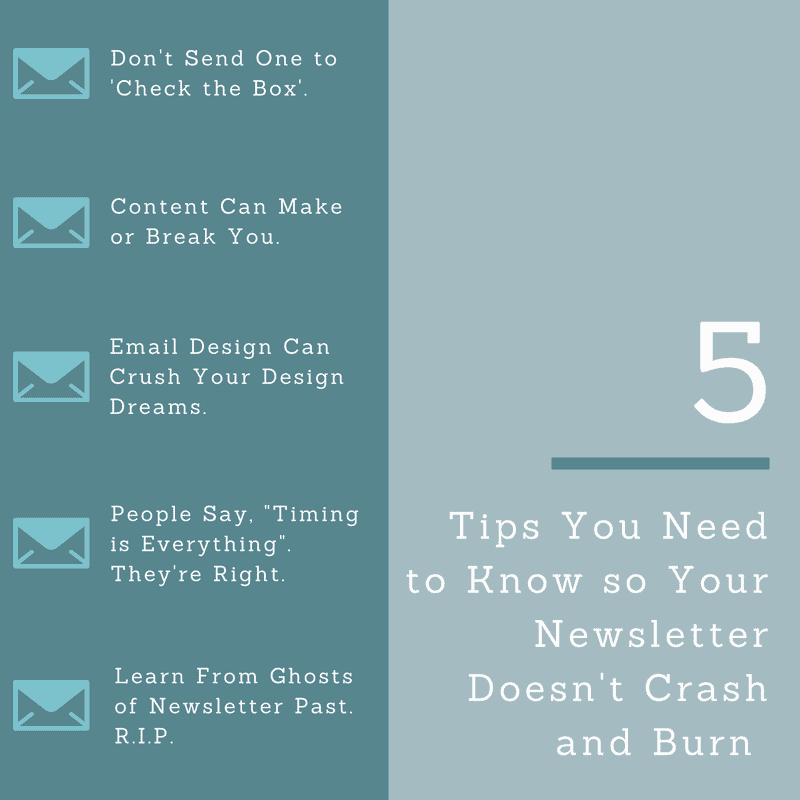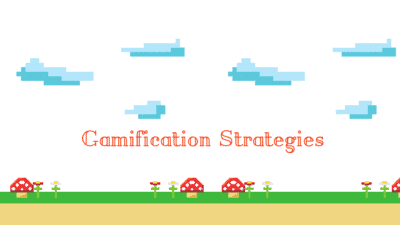5 Newsletter Tips You Need to Know So Yours Doesn’t Crash and Burn

Hi, my name is Kelsey, and I’m a marketer that has unsubscribed to a MARKETING newsletter even though I know exactly how heartbreaking that is for metrics. Everyone say it with me, *Hi Kelsey*. Welcome to Marketers Anonymous. This week, we’re talking about newsletters. More specifically, I’m covering 5 newsletter tips to help you be successful. The kind of tips that won’t tempt marketers (or anyone relevant) to unsubscribe. Let the meeting begin.
Don’t Send a Newsletter to ‘Check the Box’
It’s easy to compare yourself to your neighbor in all walks of life – including Marketing – and getting caught in the idea of ‘if Company X is doing it, we should too’ is just as easy. Before you know it, your marketing team has an overwhelming amount of marketing initiatives on its plate, most lacking substantial strategy and none of which get 100% of your commitment. That approach leads to stress, fatigue (and even failure) albeit paved with good intentions, and it’s not your fault – there simply is not enough time to do it all. Sending a newsletter might not seem like a huge commitment, but it is. By agreeing to send a newsletter, you have created expectations for your audience for months and years to come, so don’t do it just to say you did or because your neighbor did it. First, ask yourself a few questions:
- What does my organization hope to achieve by sending this newsletter?
- What is our marketing goal, and how does sending a newsletter help us achieve it?
- Is our newsletter goal realistic? Can we keep up with the cadence and supply the necessary content?
If there are valid answers backed by evidence to the questions above, send a newsletter! If not, it’s okay – head back to the drawing board and find the marketing tactic that will best support your marketing goals. Newsletters are fantastic marketing resources if done strategically, but like any successful marketing campaign, executing a newsletter takes a significant amount of time, content, resources and testing. Bottom line, if the timing isn’t right, don’t pursue a newsletter. Be prepared to answer why, but generally, if you’re going to do something, it should be done right and for good reason. After all, there are no imaginary boxes floating around for marketers to check off their list of to-dos. (myth-busted)
Content Can Make or Break Newsletter Success
Sometimes, as marketers, we think we know what is best for our audience, and we make blind assumptions paved with good intentions. Choose newsletter content based on facts, not a marketer’s intuition. There are plenty of qualitative and quantitative analytics to help make educated decisions about content:
- If you have a blog, check out the analytics. What posts got the most traffic? What were the topics? Are the original blogs still timely and relevant? If the blogs got a lot of traffic and are still fitting, use them! Delivering meaningful, interesting content that ends up driving the audience back to your site is a win-win.
- Dive into Google Analytics. Looking at traffic acquisitions and seeing the top pages website visitors go to gives marketers a good idea of what topics the audience is interested in. If those top pages are suitable for the newsletter, you have your content. If not, find an article or two from a reputable source to include as third party content or write content based on those pages.
- Your organization’s social media sites can give a lot of clues about what your audience is interested in, but if you don’t have time to sift through old tweets, it’s okay. Klout is a tool that tracks interesting articles and topics similar to the content you post, and it does the work for you, ranking both newest and most popular articles.
Design in [Marketing Automation Tool of Choice] is Different than Design in Email
Your newsletter should be both beautiful and functional, not one or the other. Duh, right? Achieving both seems like a no brainer. And it is! But, that doesn’t mean it’s easy. Gmail on a desktop will look different than Outlook on a desktop, both will look different on mobile devices, and all four will look different depending on what size smartphone or which app your recipient is using. There are SO many possibilities of where, when and how people will open your newsletter, and you can’t control any of them. Instead, take into account our newsletter tips. Focus on design aspects you can control, and do your due diligence:
Keep your design simple
Aesthetically pleasing doesn’t have to mean fancy. Using brand colors and consistent fonts goes a long way. Including images in the design should add value, but they shouldn’t be the only thing of value in the newsletter. Sometimes (a lot of the time) images don’t load right away…or at all, so putting all your eggs in one basket can backfire. Instead, using color blocks, columns, headlines or line dividers can give newsletters a clean, complete look right away.
Give your readers options
Even after you create a clean, simple design, some aspects STILL won’t show up in certain email clients. Believe me, it’s nothing personal. Just include a link recipients can click on to view your newsletter online or in their web browsers.
Add alt text to your images.
Please do this, because more often than not, your image already has text associated with it (like its file name). Change the alternate text of your image to help the audience identify it and make sense of what should be showing. This is key especially if the images have hyperlinks associated. Overall, plan for the worst, and prepare for the best!
Create a plain text version
A lot of marketing automation tools do this automatically, but always double check your plain text. If you’re duplicating previous newsletters and updating the content, it’s easy to forget to update the plain text version. In that case, you end up sending someone September’s newsletter, but when they see the plain text version, it’s August’s information. Beyond the risk of looking sloppy, not having a clean plain text version can also get marked by SPAM by the recipient’s email provider.
Send test emails
Like Nike, just do it. If you’re able, send tests to different emails hosted on different clients. What you see in Outlook can be vastly different from what you see in Gmail. PutsMail is a cool free tool that lets you send a test email to up to 10 different email addresses, so you have no excuse to not make sure that newsletter is completely vetted!
Timing Is Everything.
If you’re like me, you have heard your mom, a friend, grandparent, guardian say that too many times in life; so many times that you start wondering if it’s really possible for your eyes to roll out of your head. But it’s true, and the saying applies to newsletters, too. Remember these newsletter tips when deciding the perfect time.
- Do your research to find what days of the week and times of the day work best for your audience. If your audience consists of multiple major industries, send them different newsletters at different times, or even on different days. Chances are, the ideal send times aren’t the same (and the different industries are probably interested in different content too).
- Test the send times. Just because it works best in that industry study doesn’t mean it’s perfect for your audience. Strategically try different days, times or both to see what works best for your readers.
- Don’t be SPAMMY. Be aware of the other emails scheduled by your organization, and time your newsletter accordingly. Sending a newsletter once a month is plenty, so there is more than enough time to plan a send date.
Learn from the Ghosts of Newsletter Past
The wheel was already created. Roll with it. Sending a successful newsletter is complicated enough, so don’t try to create something new every single month; you’ll never have time to do any other marketing. In order to do this, analytics are a must. Look at delivery rates to see if your vanity email is marked as spam or open rates to see if questions work better than statements in the newsletter’s subject lines. Include hyperlinks to understand what topics readers were interested in, where you should include your most important content and how long people looked at your email. Did they read it? Skim it? Or just open it because they can’t stand to have notifications in their email? Then ask yourself how you can improve or leverage strategies that already worked.
Good luck, newsletter gurus. Let me know what your go-to newsletter tips are or, if you have any questions, let’s solve some newsletter problems below! Next, it’s time you find out…are you spamming your database? Better to know the truth than live a lie!
You Might Also Enjoy These Posts
Demand Generation vs Lead Generation
Gamification Strategies: Badges in B2B Marketing
Welcome To DemandZEN
DemandZEN specializes in Account-Based Demand Generation and solving the challenges around finding, engaging and converting target accounts into real opportunities for B2B Technology and Services companies.


